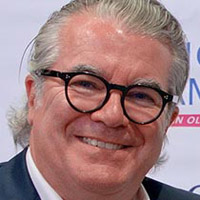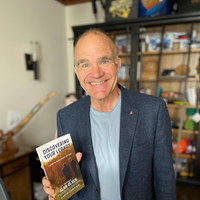Jan Geldermacher is President of Sprint Business. He joined the company in August 2016 and reports to CEO Michel Combes.
Transcript of Impact’19: Jan Geldermacher:
Alan Olsen: I’m visiting here today with Jan Geldmacher. And Jan is currently the President of Sprint,
Jan Geldmacher: Business,
Alan Olsen: Sprint Business and telecommunications. And, and welcome.
Jan Geldmacher: Thank you for having me.
Alan Olsen: Jan for the listeners, can you give your background of what you did prior to joining Sprint?
Jan Geldmacher: Okay. Well I joined Sprint about four years ago and I joined from Vodafone, Vodafone out of the UK where I worked as the CEO for Vodafone Global Enterprise for a couple of years. Vodafone Global Enterprise is the unit in Vodafone that takes care of the large multinational customers global on a global basis. I did that. Before that I worked for Vodafone in Germany running their b2b unit and Vodafone Germany. I was the CEO of British Telecom in Germany. I worked as the CTO and the telecommunications, head of T systems Deutsche Telekom for the Deutsche Telekom group. And very early, I started my career NCR, which ultimately became AT&T Global Information Solutions. And in that phase, I actually worked in the US already. So in San Diego and beautiful San Diego, couple of miles down the road from here. And I really enjoyed that.
Alan Olsen: Jan there’s a lot of discussion with 5G. Can you give us an update of what’s happening in the industry? And, and some of the things about what 5G will do with opening up new frontiers?
Jan Geldmacher: Absolutely. 5G is the next technology the next generation of wireless technology. However, I think it’s, it’s probably really something completely new compared to the to the 4G’s that we had before. When you ask customers, mostly what do you expect from 5G to happen? And they say it’s higher speed and higher capacity. But what the real differentiation from 4G over 5G is in my mind is low latency and lower battery consumption, that will enable a lot of new applications that we haven’t even thought about today, but that we can start imagining if we understand what low latency brings to the table. So I think 5G, unlike 4G, 3G is more a B2B and B2B2C enabler, rather than the b2c enabler, which was 4G 3G 2G, right? The consumers were picking up this the new G, ultimately, and then the business took over, in this case, 5G really enables new business models coming through
Alan Olsen: What are some of the applications of technologies that you see developing,
Jan Geldmacher: If you think about it, the low latency, what does it actually mean? low latency means that we can connect something as a thing. And to the machine communication or machine to data center communication, we can connect something to a data center and transmit the data in a latency that is similar to the latency we have in the human body. Just take, for example, the eyesight, if you see something, it takes 10 milliseconds to deliver the signal from your eye to the brain and create an action from it. If you think about 4G, you have latencies of you know, 60 7080 milliseconds, if you think five G, you can beat that 10 milliseconds that your eyesight is latency. Now that enables us to put intelligence into robots. And let robots interact with humans, as there were human in the same latency in the same environment. And if you think about autonomous applications, if you think about artificial intelligence or machine learning-driven applications, that is all enabled and brought to the user through low latency, network connection, so you can compare maybe 5G with the nervous system and the body as the spinal cord. So you translate the spinal cord from the human body into a network that connects the robot with the brain that is provided from the cloud, the same latency that the human body works, and that
Alan Olsen: We truly are going into new frontiers. Absolutely. And now I know had Disney’s doing the new Star Wars land. Absolutely.
Jan Geldmacher: But of course, there are applications in the area of gaming of entertainment. But I think the more exciting applications are in the area of health care, remote surgery, potentially remote, remote patients, supervision, autonomous traffic, autonomous applications in terms of in-building applications, but also traffic applications, public transportation. So everything that requires real-time reaction will be enabled through 5G.
Alan Olsen: Do you see? Do you see a slower rollout to the consumer as a result, if there are more b2b apps applications?
Jan Geldmacher: No, I think it will, it will roll out to consumers in this in the same speed. However, the use case for consumers differs from the use case of b2b, I think the you we will we will see firsthand sets are rolled out we have Sprint we have launched 5G already, based on the two-dot five gigahertz spectrum, we have launched it in four cities, and five more to follow was in the next few weeks. And of course, the first applications that we see
consumers are using is gaming applications. Your gaming, in a community of gamers in real time, is what the gaming community has waited for. So that’s exciting for the consumer from a consumer perspective. But when it comes to b2b, it’s enabling new business models. And it will take some time to build new business models to find the venture capital to invest into it and, and you know, build it up. But we can see it on the horizon happening.
Alan Olsen: If an individual wants to know if the 5G is coming to them soon in their community, how would they go about?
Jan Geldmacher: Well, they’re going to go to a website and look up the coverage maps. Give you a couple of examples we have launched in Phoenix, we will launch in Phoenix, we will launch in Los Angeles. We launched in Houston and Dallas, Fort Worth and Kansas City, we will launch in New York, we will launch in Chicago, once these nine cities are rolled out that we have on our launch plan, we will cover about to 2000 plus square miles and a couple of million potential users. So, it’s there, it’s out there. And it’s a true mobile 5G. It’s not like the millimeter-wave 5G that some of our competitors are rolling out where you have to search for the signal. As we use the two dot five gigahertz spectrum, that’s a spectrum. And in the end the frequency that’s that travels, and that propagates so that you can make a true mobile.
Alan Olsen: I just saw SpaceX launch a satellite. Well actually I think they put 60 satellites out in time. Is there a correlation between 5G and what they’re putting up? What is the rollout for infrastructure? With the 5G network? are they building more towers? Or how does it work?
Jan Geldmacher: We’re identifying our network very much. So at Sprint, we use a
technology called massive MIMO. It’s a massive MIMO antenna. That is kind of works in a dual mode, it works for 4G, and it works for 5G at the same time. So as we identify our 4G network, we already prepare for the launch of 5G. And basically, it’s switching on the software for 5G to deploy 5G services. That’s a pure terrestrial service. We need backhaul to the antennas, internal systems through fiber optics or through microwaves. And in the future, there might be a use case where satellite driven backhauling applications can support the fiber optic rollout in more rural areas where we where you don’t have a business case that works to put fiber-optics into the antennas. So there’s a corollary between what the satellite industry is doing. SoftBank group has invested in a company called OneWeb that has already launched the first satellite as well. So they go and provide a ubiquitous service that is, capable of providing backhaul services throughout the world. Ultimately,
Alan Olsen: Jan thank you for being with us today. I’ve been busy with Jan Geldmacher he’s President of Sprint Business.
Jan Geldmacher: Thank you.
Alan Olsen: Thank you
Edited for Clarity

To receive our free newsletter, contact us here.
Subscribe our YouTube Channel for more updates.
This transcript was generated by software and may not accurately reflect exactly what was said.
Alan Olsen, is the Host of the American Dreams Show and the Managing Partner of GROCO.com. GROCO is a premier family office and tax advisory firm located in the San Francisco Bay area serving clients all over the world.

Alan L. Olsen, CPA, Wikipedia Bio




